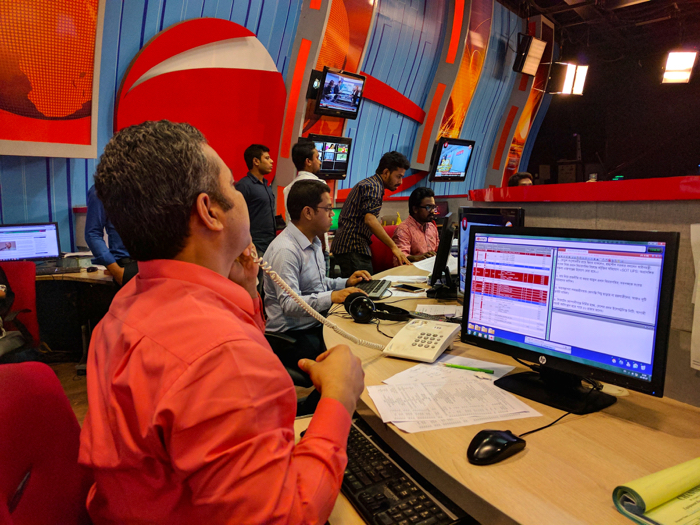
This article was written for online journalists working in Dhaka, Bangladesh.
Keeping things fresh
In this article we look at how a news website should be managed, how the front page should be built, how to keep control of the various subsections, how to update a site, the best use of links, the building of special sections, and the use of audio, video, and interactivity.
Depending on the content management system (CMS) being used by the news organisation, this person could also be responsible for selecting which images appear on the front page.
The way news stories are presented is essential. A shabby, unfocused, mistake-strewn site will reflect badly on the news organisation.
Errors in presentation, ambiguous headlines, badly captioned images, the juxtaposition of conflicting messages can and will often be saved and stored as a record of major mistakes.
There is no use taking the view that you can always correct your errors. You can, but a damaging screen grab might already have been taken. You need to do your job aware that every word you write and every decision you make is reflected online forever.
Shared responsibility
In a small newsroom, this responsibility is sometimes shared between the journalists writing for the site. In a large news operation, there will often be one person, or shift of people, who perform this function.
Some of the titles used to describe this role include duty editor, day editor, and chief sub. For the sake of this module, let’s call this person the duty editor.
The duty editor’s job is to ensure that the news is covered properly, that it is delivered on time, and that it is created to the standards set out in the editorial guidelines of the news organisation.
They also decide what the user will or will not see. And those users will be clicking on the website expecting to see what their trusted news organisation has to say on an issue.
Unfinished business
Like all 24-hour news products, online journalism has no beginning and no end.
Newspapers and magazines have editions, traditional radio and TV stations have news bulletins and news programmes, but 24-hour news operations, be they on-air, or online, keep rolling along.
If you work for a print operation with an online presence, the website must be updated around the clock.
It will be an editorial strategy decision, taken by senior managers, as to whether the news website follows the lead of the print run, or whether it has updates and sets its own deadlines more appropriate for the online audience.
Even if your organisation decides that you should not update as frequently as a broadcast organisation’s website you will still need to take care in your use of times, dates, and references to ‘today’, ‘tomorrow’, and ‘next week’.
It can confuse users if you use terms that work for your schedules, but are meaningless to theirs.
A news website duty editor will never have to build a site from scratch. She or he will arrive for a shift with a site already built and with stories being continually refreshed and updated.
Stories will have been commissioned, journalists will be working on features, interactive staff might be building components such as talking points, votes and polls, and the multimedia staff might be cropping images and choosing audio and video.
The importance of reading in
The duty editor inherits a product, and herein lies one of the first dangers. Unless he or she has read what they have inherited, they are in no position to decide what needs to be updated or replaced and what is still relevant and informative.
The duty editor’s role is not there to play with content. Their role is not to change things for change’s sake. They are there to present the news properly.
Make sure that you are up to speed before you start your shift. There have been cases of stories (already written and published online) being updated again by a new shift simply because the duty editor was not fully aware of all the stories on the site.
It is also important for the duty editor to read other news sites. They should also watch TV news and, if their organisation is a radio broadcaster, listen to those bulletins and those of the competition.
The duty editor needs to know what is happening, what has happened, what has been covered, and what still needs to be covered.
The user should never notice there has been a change of shift. The user should only feel better informed as the day goes on.
Managing the front page
There should be a handover at change of shift when one duty editor will brief his or her successor about what stories are being worked on and what can be expected in the next few hours.
Knowing your audience, and what the site statistics say about visiting habits, will help inform your decisions about when to update and when not to update.
If, for example, the peak viewing periods are 11:30 to 14:00, and 18:00 to 20:00, you should aim to update the news content significantly for 11:00 and 17:00.
You might want to make smaller changes between those times, but it is worth focusing your efforts on the times when you have the biggest audience. However, you should not withhold news update.
Breaking news and updates happen 24 hours a day, seven days a week. Knowing your audience viewing habits will help you to decide where best to focus your editorial efforts.
Updates are important. They need to show that something significant has happened. There is no point in changing stories on the home page if there have been no meaningful developments.
You can make small changes, for example updating the image, but you must not use cosmetic alterations to fool readers into thinking that these indicate important updates when the underlying content contains nothing new.
If a user is attracted by a new headline and image but finds that the main substance of the story has not changed, they might feel let down.
Think carefully before you drop a story featured on the front page or a section index page. These are the most visible areas of your site. If the story is not featured here the chances are that it won’t attract the views it would otherwise.
Story shelf life
Consider how much a story costs in terms of time, effort, and resources before reducing it to a headline link in the ‘other news’ section. Your job is to manage the content intelligently in terms of its editorial impact and in terms of its cost and benefit to your news organisation.
Similarly, you must decide on which stories your journalists should invest their time and effort. When making this decision, you need to bear in mind the audience profile, the news operation’s core news strengths, and the story’s shelf life. This will often be the duty editor’s responsibility.
Several journalists might be contributing to one story. None of them is likely to have the overview you have. They will continue to offer fresh content and update the story until they are told to stop. The duty editor must know when to save a story as a complete version of an event and when to start a new story.
By evaluating the shelf life of a story, you will also be deciding how much effort to put into it.








